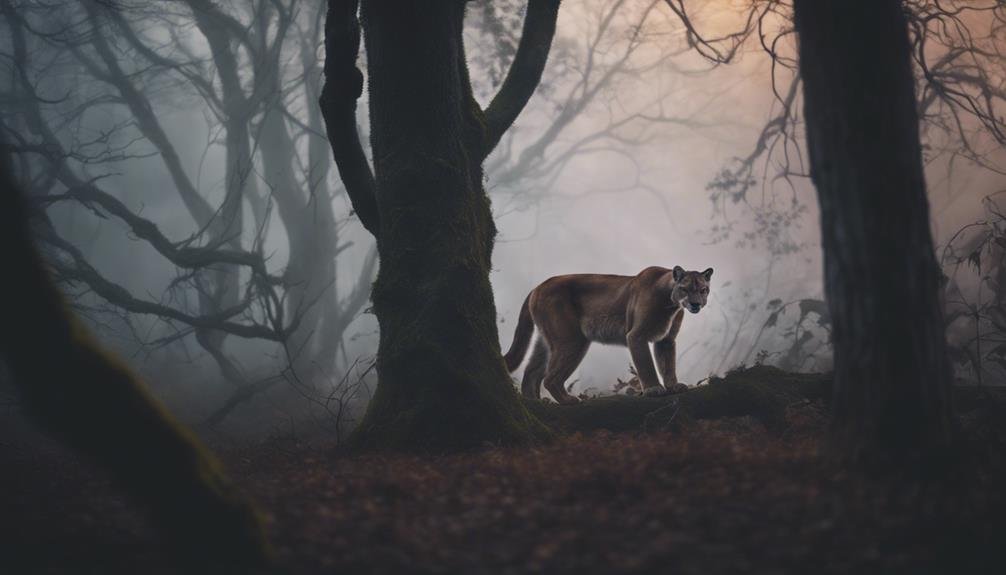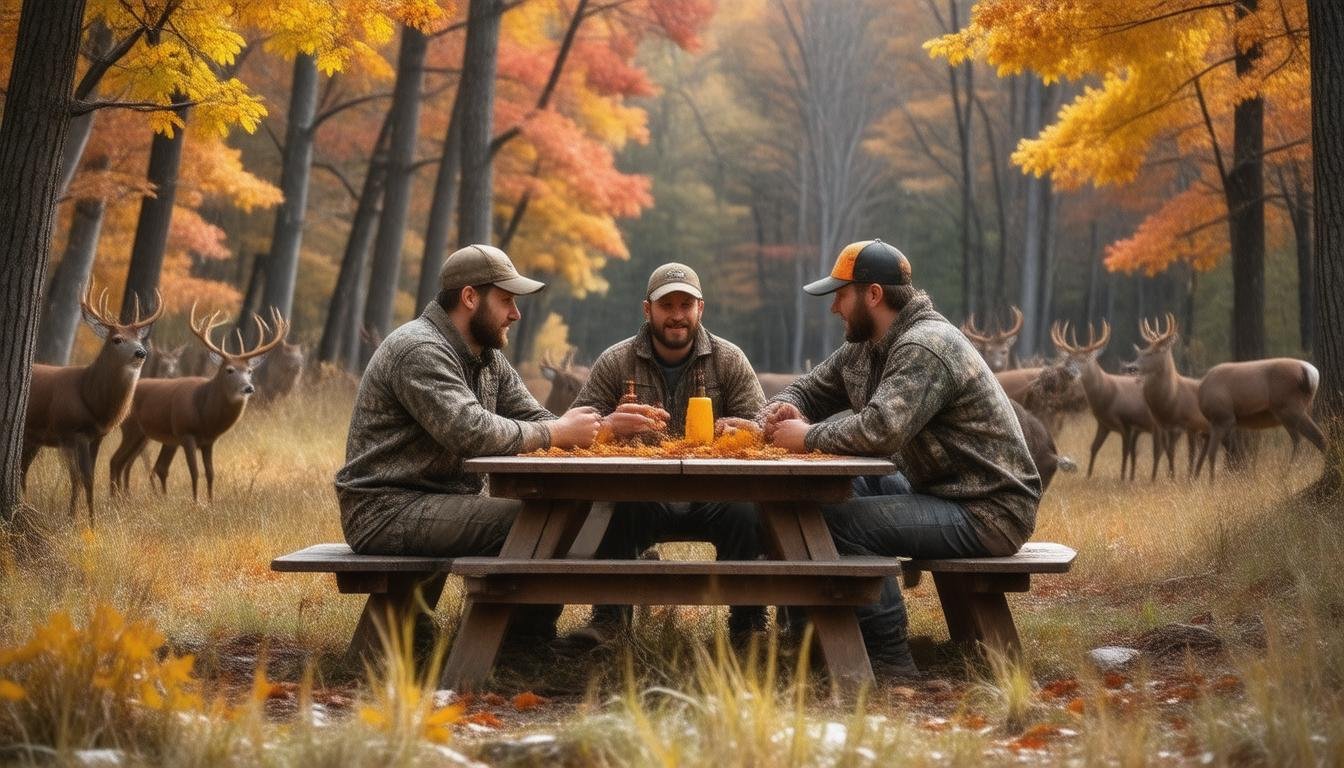As I venture into cougar country, I know that tracking these elusive predators demands patience, skill, and knowledge of terrain and behavior. Focus on areas with high prey density increases the chances of a successful hunt, and scat, scratch marks, and other signs of recent activity are essential signs to look for. But it's not just about the hunt – it's about the primal connection with nature and the rush of adrenaline that comes with it. And as I set out on this thrilling game of cat and mouse, I'm driven by the promise of unpredictable adventures that will push my limits and ignite a deeper passion for the wild.
Key Takeaways
- Patience and persistence are essential in tracking cougars, as they often follow game trails and exhibit unpredictable behavior.
- Understanding cougar behavior and habitat is crucial in anticipating their movements and setting up an effective ambush.
- Hounds are indispensable components of the cougar hunt, amplifying the thrill of the chase and providing an unmatched sense of satisfaction.
- The thrill of the chase lies in the primal connection with nature and the rush of adrenaline, making memorable moments abound from sighting to stalk.
- Embracing fair chase ethics can safeguard hunting traditions while respecting the quarry and the environment, ensuring the integrity of hunting practices.
The Art of Tracking Cougars
As I lace up my boots and shoulder my rifle, I know that tracking cougars demands a unique fusion of skill, patience, and knowledge of the terrain and cat behavior. I've honed my tracking strategies over the years, learning to read the subtle signs left behind by these elusive predators. My hunting techniques involve a combination of observation, experience, and intuition. I know that cougars often follow game trails, so I focus on areas with high prey density. I also look for scat, scratch marks, and other signs of recent activity. By understanding the cat's behavior and habitat, I can anticipate its movements and set up an effective ambush. With patience and persistence, I increase my chances of a successful hunt.
Challenges of the Mountain Lion Hunt
Mountain lion hunting is not for the faint of heart, as I've faced numerous challenges in my pursuit of these elusive predators, from traversing rugged terrain to coping with harsh weather conditions. The physical demands of tackling steep cliffs and rocky chutes are formidable, and the harsh weather conditions can be unforgiving.
| Challenge | Description |
|---|---|
| Rugged Terrain | Steep cliffs, rocky chutes, and dense forests |
| Harsh Weather | Extreme temperatures, heavy snowfall, and strong winds |
| Physical Demands | Tackling challenging terrain, carrying heavy gear |
| Unpredictable Behavior | Cougars are elusive and unpredictable, making tracking difficult |
Despite these challenges, the thrill of the chase keeps me coming back for more. With each hunt, I'm reminded of the importance of skill, patience, and knowledge of the terrain and the cat's behavior.
Elusive Prey in Rugged Terrain
In the rugged terrain of cougar country, where steep cliffs and rocky chutes provide the perfect camouflage, I've learned to trust my instincts and believe in the presence of these elusive predators, even when they're nowhere to be seen. As I navigate the Wild Escapes of this unforgiving landscape, I'm reminded that cougars are masters of concealment, blending seamlessly into the Rugged Landscapes they call home. Experience has taught me to read the subtle signs, to recognize the faint tracks and scat that betray their presence. It's a cat-and-mouse game, where patience and persistence are essential. I've spent countless hours tracking, only to come up empty-handed, yet the thrill of the chase remains, driving me to continue the pursuit of these enigmatic creatures.
The Great Debate on Fair Chase
Critics of traditional cougar hunting with hounds argue that the practice undermines the fundamental principles of fair chase, sparking a contentious debate that has led to restrictions in several Western states. As an experienced hunter, I understand the concerns surrounding fair chase ethics. Hunting traditions, like those involving hounds, are often scrutinized for their perceived lack of fairness. However, I believe that using hounds can be a challenging and rewarding experience that still upholds fair chase principles. The thrill of the chase, the skill required to track and pursue, and the bond between hunter and hound all contribute to an experience that is both physically and mentally demanding. By embracing fair chase ethics, we can safeguard that our hunting traditions remain intact while respecting the quarry and the environment.
Hounds: Essential for the Hunt
For many hunters, including myself, hounds are indispensable components of the cougar hunt, amplifying the thrill of the chase and providing an unmatched sense of satisfaction. When it comes to hound selection, I look for breeds with a strong prey drive, agility, and endurance. Proper hound training is also essential, as it requires patience, consistency, and positive reinforcement.
| Hound Breed | Characteristics |
|---|---|
| Black Mouth Cur | Strong prey drive, agile, and energetic |
| Redbone Coonhound | Excellent trackers, fast, and persistent |
| Plott Hound | Intelligent, athletic, and tenacious |
| Walker Hound | Agile, energetic, and keen sense of smell |
The Bond Between Hunter and Hound
As I reflect on my experiences with hounds, I've come to realize that the bond between hunter and hound is forged through trust, mutual respect, and a deep understanding of each other's strengths and limitations. This synergy is built on a foundation of consistent training, clear communication, and shared experiences. The hound's keen senses and instinctual drive are perfectly complemented by the hunter's strategic guidance and situational awareness. In return, the hunter relies on the hound's unwavering dedication and unrelenting pursuit. This harmonious relationship fosters hound camaraderie, where both hunter and hound develop a profound appreciation for each other's abilities. The resulting hunter relationships are characterized by empathy, trust, and a deep-seated respect, ultimately culminating in a thrilling and rewarding hunting experience.
Cougar Behavior and Habitat Insights
While traversing Montana's rugged terrain, I've learned that cougars are masters of concealment, exploiting the state's labyrinthine landscape to remain elusive and sparsely populated. These solitary predators thrive in vast, fragmented habitats, often traversing extensive territories in search of prey, mates, and suitable habitats. Wildlife corridors play a vital role in connecting isolated habitats, allowing cougars to disperse and maintaining genetic diversity. Territorial boundaries are fiercely defended, with males occupying larger territories that often overlap with those of multiple females. Understanding these spatial dynamics is essential for effective conservation and management strategies, as well as for hunters seeking to track and pursue these elusive cats. By recognizing the intricacies of cougar behavior and habitat, we can better appreciate these apex predators and the ecosystems they inhabit.
The Reward of a Successful Hunt
After days of tracking and pursuing, the thrill of finally treeing a mountain lion is unparalleled, with the rush of adrenaline and sense of accomplishment making every challenging moment worthwhile. The reward of a successful hunt is not just about the quarry, but about the personal fulfillment and hunter's pride that comes with it.
| Aspect | Description |
|---|---|
| Thrill of the Chase | Rush of adrenaline and sense of accomplishment |
| Personal Fulfillment | Feeling of pride and satisfaction |
| Hunter's Pride | Accomplishment and pride in skills and teamwork |
| Camaraderie | Bonding with fellow hunters and hounds |
| Memories | Lasting memories of the hunt and experience |
The satisfaction of overcoming the challenges of the hunt, from tracking to treeing, is unmatched. The experience is not just about the mountain lion, but about the journey, the people you share it with, and the personal growth that comes with it.
Beyond the Hunt: Cooking Cougar Meat
I still recall the skeptical looks I received when I first served mountain lion meat to my friends, but the tender, flavorful dish quickly won them over. As a hunter and food enthusiast, I've always been fascinated by the culinary potential of cougar meat. Rich in protein and low in fat, it offers a unique opportunity to explore new flavors and textures in the kitchen. By embracing cougar meat as a sustainable meat alternative, we can redefine our food culture and promote a more environmentally conscious approach to hunting. By sharing my experiences and recipes, I hope to inspire others to rethink their perceptions of game meat and explore the rich culinary possibilities it has to offer.
Changing Perceptions Through Sharing
By inviting non-hunters to share a cougar meat dinner, I've found that the experience can profoundly shift their perception of hunting, transforming skeptics into supporters. This phenomenon can be attributed to the power of social norms, where shared experiences and communal eating can alter cultural significance. When non-hunters engage with hunting through food, they begin to understand the cultural significance of hunting as a means of sustenance. This newfound understanding can lead to a shift in social norms, where hunting is viewed as a crucial part of our food system. By sharing cougar meat, I've witnessed a tangible change in perception, as guests begin to appreciate the skill, patience, and knowledge required for a successful hunt. This experiential learning has the potential to redefine the cultural significance of hunting in the eyes of non-hunters.
Reflections on the Thrill of the Chase
Pursuing a mountain lion through rugged terrain, I've come to realize that the thrill of the chase lies not in the kill, but in the intense, primal connection with nature and the rush of adrenaline that comes with it. As I navigate the unforgiving landscape, I'm struck by the hunter's high – an intoxicating cocktail of excitement and fear. Memorable moments abound, from the initial sighting to the final stalk. The rush experiences are addictive, fueling my passion for the hunt. Personal gratification comes not from the kill, but from the fierce connections forged with nature and my fellow hunters. Wild adventures like these are what drive me to return to the wilderness, again and again, seeking that next great thrill.
Frequently Asked Questions
Can I Hunt Cougars in Areas With High Human Population Density?
As I venture into cougar hunting, I must consider urban hunting restrictions, ensuring I'm not pursuing these elusive creatures in areas with high human population density, where population dynamics and safety concerns come into play.
Are Mountain Lions Protected in Certain Regions Due to Conservation Efforts?
As I venture into the world of mountain lions, I discover that, yes, they are protected in certain regions due to conservation efforts, specifically habitat preservation, which affects their conservation status in those areas.
How Often Do Hunters Encounter Other Predators While Tracking Cougars?
"I've encountered a gazillion predators while tracking cougars, but in reality, competitor dynamics come into play, making it a rare occurrence; territorial boundaries are respected, and we seldom cross paths with other predators, like bears or wolves, in the wild."
What Safety Precautions Should Hunters Take When Navigating Rugged Terrain?
When traversing rugged terrain, I prioritize terrain awareness, recognizing potential hazards like steep slopes and inclement weather. I employ survival strategies, such as carrying a first-aid kit, staying hydrated, and knowing emergency protocols to guarantee a safe hunting experience.
Can Cougar Meat Be Consumed by People With Certain Dietary Restrictions?
As a hunter, I wonder if cougar meat can be consumed by people with certain dietary restrictions. For instance, can it be certified as Halal or Kosher, offering alternatives for those with religious or cultural dietary needs?
Conclusion
As I stand victorious, the cougar's tawny fur glistening in the sunlight, I'm reminded that the thrill of the chase lies not in the kill, but in the pursuit. The rugged terrain, the cunning cat, and the hounds' relentless drive – all culminate in a dance of predator and prey. The rush of adrenaline still courses through me, a tribute to the primal allure of the hunt. I've faced challenges, debated ethics, and savored the reward – and in this moment, I'm hooked, forever bound to the thrill of the chase.









